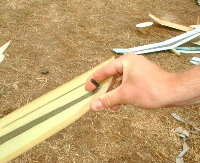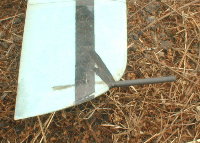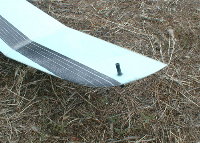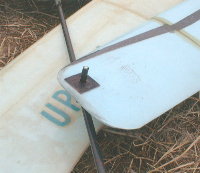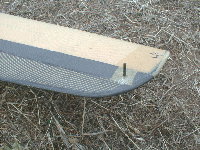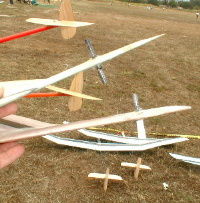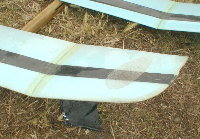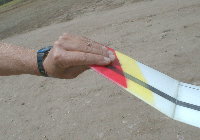|
International Hand Launch Glider Festival |
|
| Wing Tips/Pegs |
|
| This is the finger grip of John Asplund. Prior to launch, John uses his thumb to control the handling of the wingtip. As he spins for the launch, he will remove his thumb. | |
| This is the wingtip peg of Joe Wurts on the polyhedral Raptor. There is one main theory here. When the pegs are placed, the peg is generally installed far forward in the wing. Some suggest that the peg needs to be close to the CG. Due to the sweep of the wing, this configuration permits the grip to be near the CG. I heard Joe's comments on this was that he could not put all the launching force he had onto this configuration and control it well. It does, however, solve some of the drag questions pilots have asked contrasting the vertical pegs in the wings. | |
| Here is a simple installation of the peg without extra reinforcement. | |
| Here is a simple installation of the peg with extra reinforcement. Some pilots had extra layers of glass, kevlar or carbon mat. Pegs are made from CF arrow shafts. Some pegs tried to address streamlining and used a teardrop shaped aluminum tube originally used in landing gear fairings, which is produced by K&S. An alternative is to use a flat piece of flattened aluminum bar. With the thin side facing forward, there is reduced drag, and with the wide side facing the pilot, it provided additional resistance to tearing out of the wing. | |
| Here we have a quick peg installation example. The wrap of carbon tows prevent the pegs from wearing loose during use. | |
| Here we see the addition of kevlar cloth under the wing surface to prevent tearing and other damage. | |
| We see here on Phil Barnes' Logic, the use of both carbon fiber and kevlar reinforcement of the peg in the wing. | |
| This is the tip peg used by Rudy Seigel. | |
| When pegs are not used, often times another rough surface is added in order to reduce the amount of slippage and gripping strength required to launch the plane. Although not pictured here, Tom Hoopes added sandpaper to the lower surface of the wing where his thumb touches the wing. Tom warned me to watch out for using sandpaper as it rubs your thumb raw in practice. Personally, I used sandpaper on the side of my fuselages for javelin launches and it quickly took off the surfaces of my fingers. | |
| This is the grip of Bill Watson. Bill has reinforced the tip and uses a rosin, which is used by rock climbers to have a better grip. Some of the rosin stays on the wing tip, which also requires some cleaning since dirt can stick to the wing surface. | |
|
|
|
